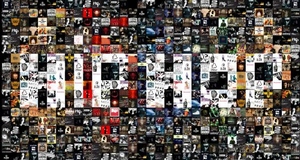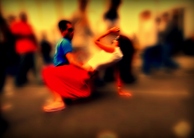Hip-Hop is for Everybody: Examining the Roots and Growth of Hip-Hop
By
2012, Vol. 4 No. 05 | pg. 2/2 | « The images idealized by the major record labels in modern day hip-hop might actually be a matter of catering to consumers. Currently, whites consume 70% of hip-hop produced and at this day and age it is more economically viable to advertise hip-hop more to whites than to the black community that it originally derived from. (Hurt, 2006) Whites have admitted to being attracted to the hyper violent and sexual themes presented in many modern rap songs, thus contributing to the continuation of these themes. In Hurt’s documentary, a group of young white suburbanites were asked why rap and hip-hop are attractive, responding that by listening to rap, they felt that they were experiencing a different culture; a culture rooted in black American history. (Hurt, 2006) Essentially, the argument is that white people believe that by listening to rap, they are getting closer to blackness. (Condry, 644) However, this image of blackness presented in current rap songs and videos is not very flattering and falsely represents the black community in a laundry list of negative ways, including being sexist, overly violent, egotistical, and so on. This phenomenon is problematic as there is a danger that people may perceive blacks as the hyper-violent and sexist people they see in videos. Like the major record labels, many businesses and corporations have turned to utilize hip-hop to turn a profit. Hip-hop has been used to advertise numerous corporations, organizations, and causes, from McDonald’s to Coca Cola to NIKE to MTV to anti-drug campaigns, and so on. (Rose, 17) Even hip-hop fashion has become very popular and chic, spreading to “encompass a steady clientele of various racial (including white), ethnic, and natural identities.” (Heath, 859) Hip-hop has gone from representing the voice of the black community to representing countless companies, brands, products, fashion lines, and more.Not only has hip-hop spread from being consumed solely by urban blacks to being popular throughout the United States, but currently, hip-hop has been “internationally recognized as a dominant commercial force.” (Kun, 580) In Japan, as in the United States, many companies combine hip-hop’s “outlaw stance” with “conspicuous, brand-name consumption” to successfully promote the business, providing further evidence that hip-hop represents companies and products and not just people. (Condry, 640) It is fair to conclude that hip-hop has permeated Japanese society, establishing a strong fan base, by the heavy use of hip-hop in Japanese marketing. However, there are many fans and critics of hip-hop that suggest that foreigners cannot truly understand hip-hop. (Condry, 644) These critics believe that hip-hop is so strongly rooted in black American culture and history, that foreigners could never grasp the social underlying themes present in the genre. These claims are valid when considering that in other countries, such as Japan, “Blackness” and hip-hop culture “became a fad to be consumed, without the obligation of learning about or understanding Black people.” (Condry, 644) However this seems to be a shallow perspective on other cultures. In Japan, for example, there are many Japanese hip-hop artists and fans who do make the effort to learn about hip-hip and how its history relates to black Americans. (Condry, 649) Additionally, many Japanese rappers do in fact rap about societal ills from “hierarchies of class” as well as youth and gender issues, using their lyrics to “highlight divisions within Japanese society.” (Condry, 658,665) While these Japanese artists do not rap about the same exact issues that black rappers have historically rapped about, they still do bring attention to cultural, political, and societal ills; something that is engrained in hip-hop’s history. By rapping about Japan’s societal problems, hip-hop has come to represent a portion of the Japanese community, just as it has come to represent the black community in the United States. Hip-hop has ultimately lost its original meanings much in the way that jazz, blues, gospel, and other types of historically black music have lost theirs throughout the years from being heavily commercialized and expanded to encompass a much wider fan-base. While hip-hop is no longer solely the voice of the black community as it once was, it has grown, becoming the voice of a variety of communities and peoples, as well as products and companies. Hip-hop can now be found in places nobody would have expected years ago, from television commercials and video games to public service announcements and political campaigns. Yes, it is true that with the ever commercialization of hip-hop, there has been an influx of music produced that is devoid of any social meaning, however, there will always be artists that still believe in the art form as an expression of social change. The transformation of hip-hop music from a generally urban and poor audience to a global commercial force brings us closer to a world where “Me, you, everybody” comprises hip-hop. (Mos Def, 1999) In this global market of hip-hop, entirely new groups of people from a score of different backgrounds and cultures can take advantage of the genre to voice their own problems with the government, police oppression, marginalization, and numerous other societal issues. This spreading of hip-hop music can provide social groups and outlets for underrepresented people in other countries that have not had any before. Hip-hop has essentially opened its doors to accept a new group of consumers and producers that span the entire globe. Ultimately, hip-hop is now open to everyone; the four basic elements of rap, deejay, break dance, and graffiti are available to a new global and commercial world. However, with the globalization of hip-hop there is potential for the spreading of the “Gansta Rap” ideology of black people as hyper-masculine and over-violent. While the music may no longer be entirely as politically, socially, and culturally charged, the roots remain the same and these roots can never be altered. When the history of hip-hop is discussed, people will always be directed to the ingenuity of blacks in the South Bronx during the late 1970s who started the movement; it is clear that the genre is historically embedded in the black community and that cannot be denied. ReferencesHip-Hop: Beyond Beats and Rhymes. Dir. Byron Hurt, 2006. Condry, Ian. “Yellow B-Boys, Black Culture, and Hip-Hop in Japan: Toward a Transnational Cultural Politics of Race.” Positions: East Asia Cultures Critique 15 Winter 2007: 637-671 Fitts, Marko. “Drop It Like It’s Hot’ Culture Industry Laborers and Their Perspectives on Rap Music Video Production.” Meridians: Feminism, Race, Transnationalism 8 2007: 211-235 Heath, Scott R. “True Heads: Historicizing the Hip_Hop ‘Nation’ in Context.” Callaloo 29 Summer 2006: 846-866 Kun, Josh. “Two Turntables and a Social Movement: Writing Hip-Hop at Century’s End.” American Literary History 14 Fall 2002: 580-592 Mos Def. “Fear Not of Man.” Black on Both Sides. Rawkus Records, 1999. Rose, Tricia. Black Noise: Rap Music and Black Culture in Contemporary America. Middletown, CT: Wesleyan University Press, 1994. Suggested Reading from Inquiries Journal
Inquiries Journal provides undergraduate and graduate students around the world a platform for the wide dissemination of academic work over a range of core disciplines. Representing the work of students from hundreds of institutions around the globe, Inquiries Journal's large database of academic articles is completely free. Learn more | Blog | Submit Latest in Music |


















